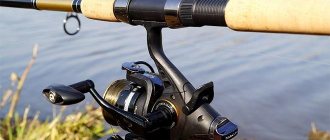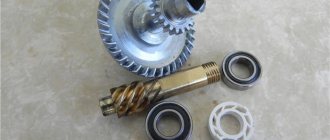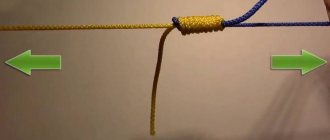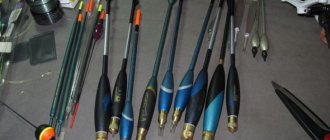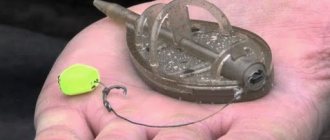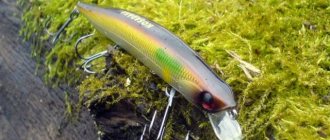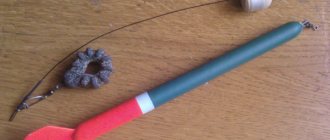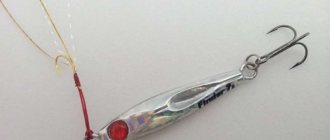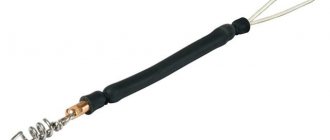What is backing on a reel spool and why is it needed?
Backing is a winding line that is wound onto the reel spool, before the main line.
That is, this is a preliminary winding of the fishing line, the task of which is to reduce the depth of the spool. It is worth noting that not all spools require backing. Low-profile spools, which have a shallow side, do not require backing, as they are designed specifically for thin cords of small diameter.
The backing is wound into deep spools so that the quality of the line winding is higher and the friction of the line on the side of the spool is less. This allows you to make longer casts, which are especially important when choosing spinning reels, feeder and carp.
If you want to purchase spinning reels, we recommend that you familiarize yourself with the arsenal of models in this online store using the green link.
What is it usually made from?
Not so long ago it was believed that winding the required thickness onto a reel spool was quite possible using ordinary electrical tape , nylon cord or a suitable thickness of rubber . Now professional fishermen, who know well what backing is in fishing, do not consider these materials for its manufacture.
Modern technologies make it possible to produce increasingly thinner fishing lines with high strength, allowing you to catch large fish. In addition, new generation reels and blanks are more sensitive and balanced. All these factors, with a professional approach to fishing, require that the line on the reel be wound appropriately - evenly, without overlaps and at the proper level.
Electrical tape and other materials used earlier initially form irregularities and differences , which are subsequently repeated by the wound fishing line. In addition, under the influence of high loads, which often occur during fishing, such backing can deform even more, increasing the unevenness of the laying of the main line.
Nowadays, in order to make high-quality backing on a spool, two materials are mainly used:
- ordinary, cheapest, monofilament line of small diameter;
- sewing threads from nylon No. 40 or similar in diameter.
Using them, winding the backing onto a reel can be done using a standard line layer , which will make its surface as smooth as possible.
If you decide to use fishing line, try to keep its diameter slightly smaller than the diameter of the main fishing line (cord) . This will reduce the likelihood that it will fail under load between turns of backing. An old, no longer needed fishing line is quite suitable for this task. The diameter of the backing line can be from 0.1 to 0.15 mm.
Expert opinion
Knipovich Nikolai Mikhailovich
Zoologist, hydrobiologist. I am interested in fishing at a professional level.
Attention! If you don't know how to tie the backing to the cord, we can recommend a knot called "loop to loop." It is quite simple and reliable.
Using nylon thread has some advantages:
- It is soft and fits almost perfectly onto the surface of the spool.
- Such a winding, unlike one made from fishing line, does not scroll around the base of the spool under emergency loads, for example, when fishing for large fish over long distances.
- It is much lighter than the main line.
- It is from this that it is better to make backing under the wicker.
Both fishing line and nylon threads are quite suitable for making high-quality winding on the base of the spool. The choice of specific material should be based on the angler's preferences.
Backing winding process
It is very convenient when a spare spool is included with the reel, this simplifies the task. After all, we need to choose a winding such that the wound main line is hidden under the side by only 1-2 mm.
In order not to guess with the number of turns, you first need to wind the main line onto a spare spool, and tie backing to its end, the winding of which should be 1-2 mm from the side. Next you need to rewind the whole thing from the spare spool to the main one. When rewinding, the backing will be on the inside and the main line on the outside. That's the whole process.
It is recommended to wind the line under tension, or even better, soaked in water, this ensures better laying.
It is worth noting that if your line from the box has a large diameter and length, backing may not be needed at all. You can check this on the spool; the capacities of fishing lines of different diameters should be written there.
You can clearly see the process of backing a spinning reel onto the spool in this video. Dmitry Salapin explains everything in detail and shows every nuance of this case.
We also advise you to familiarize yourself with the process of clipping with and without an elastic band. Clipping on the reel spool is a way to fix the fishing distance, which allows you to cast feeders or baits at the same distance. You can learn about fishing line clipping here.
How to wind backing for a reel
Today we offer the topic: “how to wind backing for a reel” from professional fishermen. We tried to cover the topic as fully as possible. You can ask all questions in the comments after the article.
Every experienced angler knows that careful preparation for fishing increases the chances of success. Quite often this preparation must include backing the reel.
Properly wound fishing line can, in certain cases, play an important role, both when casting baits and when fishing for prey. Few novice fishermen are able to appreciate the importance of this element of gear; understanding this comes with experience. Let us consider in more detail in what cases, how and from what it is made.
Not everyone knows and understands what backing is. In simple words, backing is a special lining made on the reel spool, which serves to increase its diameter . This is primarily necessary when the amount of main line is not enough to completely fill the spool, as well as to use it more economically. If you use backing for the reel, it will be much easier for you to wind it exactly to the desired level.
In addition to saving money, this element allows you to slightly reduce the weight of the loaded reel , which is especially important when fishing with light and ultra-light gear. This is especially true when working with spinning-type reels, since the quality of the line coming off the spool very much depends on the distance at which its upper layer is located from the upper border of the side. It is believed that this value should be within 1-2 mm .
If this parameter exceeds 4 mm , long-distance casting will be difficult , and when the cord is wound flush with the sides, there is a high probability of it getting tangled. Therefore, experienced spinning players who know what backing is on a reel always monitor this indicator.
Despite the apparent simplicity of this element, to achieve maximum efficiency when using it, backing on a spinning reel must be carried out in accordance with certain rules, using suitable materials.
Not so long ago it was believed that winding the required thickness onto a reel spool was quite possible using ordinary electrical tape , nylon cord or a suitable thickness of rubber . Now professional fishermen, who know well what backing is in fishing, do not consider these materials for its manufacture.
Modern technologies make it possible to produce increasingly thinner fishing lines with high strength, allowing you to catch large fish. In addition, new generation reels and blanks are more sensitive and balanced. All these factors, with a professional approach to fishing, require that the line on the reel be wound appropriately - evenly, without overlaps and at the proper level.
Electrical tape and other materials used earlier initially form irregularities and differences , which are subsequently repeated by the wound fishing line. In addition, under the influence of high loads, which often occur during fishing, such backing can deform even more, increasing the unevenness of the laying of the main line.
Nowadays, in order to make high-quality backing on a spool, two materials are mainly used:
- ordinary, cheapest, monofilament line of small diameter;
- sewing threads from nylon No. 40 or similar in diameter.
Using them, winding the backing onto a reel can be done using a standard line layer , which will make its surface as smooth as possible.
If you decide to use fishing line, try to keep its diameter slightly smaller than the diameter of the main fishing line (cord) . This will reduce the likelihood that it will fail under load between turns of backing. An old, no longer needed fishing line is quite suitable for this task. The diameter of the backing line can be from 0.1 to 0.15 mm.
Using nylon thread has some advantages:
- It is soft and fits almost perfectly onto the surface of the spool.
- Such a winding, unlike one made from fishing line, does not scroll around the base of the spool under emergency loads, for example, when fishing for large fish over long distances.
- It is much lighter than the main line.
- It is from this that it is better to make backing under the wicker.
Both fishing line and nylon threads are quite suitable for making high-quality winding on the base of the spool. The choice of specific material should be based on the angler's preferences.
After you have selected the material from which the winding will be made, you need to determine as accurately as possible what height it should be, which means how much of this material (fishing line or nylon thread) will be needed.
There is a way that will allow you to do this quickly and accurately. To do this we need a spare spool from the reel. As a rule, they always come as a set and differ only in the material of manufacture, one is metal and the other is plastic. If it is not there, additional rewinding of the line onto an empty reel will be required.
Winding backing using a spare spool should be done as follows:
- The main line (or braid), having previously been threaded through the rings of the rod, must be tied to a spare spool attached to the reel.
- You need to wind this line in the same way as usual before fishing. It’s good if you have an assistant who will hold the drum and make sure that the desired tension is created.
- After winding the main fishing line (cord), to its free end, using a reliable knot, you need to tie the material that is selected to form the backing.
- Further winding of the fishing line with attached backing is carried out to the desired level, until the distance to the edge of the spool side is reduced to 1 - 2 mm.
- The backing is then cut off near the rod tip and the spare spool is removed from the reel.
- The main spool is installed on the reel, the backing is pulled through the rings and attached to it. The bagging unit must be reliable, preferably double.
- Winding the main line or cord with attached backing is done in the reverse order.
As a result, we get a correctly executed winding of the main cord (line) onto the reel with the required amount of winding.
In the video we'll see what backing is and how to wind it correctly:
Backing, of course, is not a mandatory element in amateur fishing; it does not greatly affect the catchability of the gear, but still its use significantly increases its ergonomics. Most experienced anglers, especially those who fish with light tackle, use it all the time.
In principle, everything written in this article is no secret for those who engage in spinning fishing. At least that's what I thought. The idea to write a kind of instruction on how to do proper backing came spontaneously. And that's why. One of my friends recently became interested in spinning. As usual, I purchased the necessary set of gear and started going fishing. Sometimes with me, sometimes alone. And then a month later he calls me and tells me that his cord is constantly getting tangled, the baits are periodically shooting off, when casting, extraneous sounds are heard and there are strange jerks. Sinking on the reel, I began to find out the details, a friend sent me a photo of the reel, and immediately everything became clear - there is no backing, the reel is size 2500, and the unwinding of the cord on it is only 130 meters. Well, the reason seems to have been clarified, and therefore I advised him to rewind and rewind the cord. He said it and forgot.
Perhaps someone does backing in their own way; in fact, there are many options. Some people are happy with a fishing line as a reel, but I still prefer a cord, since it does not stretch and is more reliable if suddenly the main cord is worn out by a trophy fish. Someone calculates the amount of cord for backing using a calculator and mathematical calculations, since, knowing the diameter of the cord and the footage selected per revolution of the reel, it is quite possible to estimate the length of the reel. This is also possible, no doubt, but I am a supporter of practice, not calculations: it is important for me to see what the coil will look like in the end. In addition, the method with mathematics has its own nuances: often the cords in reality have a diameter less than that indicated on the package, often the backing is connected from several pieces of different cords, so the calculation is not always accurate in the end. Yes, the method I propose is longer and more tedious, but I’m okay with patience, and it’s even nice to carve out half an hour to tinker with your favorite gear. Again, fine motor skills are stimulated! ?
Determining the amount of fishing line needed
Each modern reel is marked with capacity. For example, on spinning reels this is written on the spool:
Most often, these inscriptions refer to a branded fishing line, which may differ from the one you purchased, but these numbers are quite suitable as a guide. If you are using braid, it is better not to rely on these designations, since the braid itself is soft, it will take more of it.
So, if your fishing line is enough with a margin of 20%, then you can safely move on to the winding section, but if this figure is less or you are using braid, it is better to play it safe and read about backing.
Backing may also be needed if you do not need long casting or if you want to put part of the line on another reel. Backing is a fishing line or an old cord designed to fill excess space on the spool, in other words, winding under the main fishing line.
The backing should be stronger than the main line, but at the same time not differ much in diameter from it, then the winding will be smoother.
What to use for backing?
What is the backing for the reel made of? Recently, for these purposes, fishermen used electrical tape, a cloth patch, or a piece of rubber cut from a bicycle tire. Now these options are rarely used for several reasons:
- These materials are wrinkled, as a result the winding height is violated and irregularities appear;
- Insulating tape and adhesive plaster have gluten, which leaks out at high temperatures, stains the fishing line, and gets on the rings;
- It is difficult to correctly calculate the amount of reeling layer; you have to repeatedly wind the line from the spool, add or remove material.
The main materials used for backing are monofilament or multifilament fishing line.
The backing should have a diameter close to the thickness of the main line. This will allow you to wind it as efficiently as possible, the lower layers of the main thread will not cut into the winding, the casting range will be maintained, and the laying will be even. With this approach, the reel will not fail at a crucial moment and will not ruin your fishing.
When fishing with monofilament line, the backing should also be made of monofilament. Angling with a cord requires the use of braid of the same thickness; nylon can be used.
In order to save on the purchase of a separate reel of line for backing, it is advisable not to throw away the worn-out warp thread at the end of the season. After drying it, it must be wound from a reel onto a reel, saving it for next year. Before the first foray to the river bank in the new season, the remaining section will certainly come in handy as a basic winding for the spool.
Some fishermen wind a nylon thread under the main line. Its main advantage is its low cost. However, this backing has more disadvantages:
- absorbs moisture;
- dries slowly;
- Mold may form;
- the cord will deteriorate.
Therefore, it is better to refuse to use nylon. Or you can look for a specialized fishing thread with water-repellent impregnation, but the price is not comparable to monofilament or budget braid.
Features of winding on a multiplier reel
Modern multipliers are a very complex mechanism. It is important to know that when using this type of reel, you cannot use backing; the fishing line must be uniform and without unnecessary ligaments.
At the same time, it is desirable that the fishing line be wound with the correct tension and right under the edge. If these rules are not followed, the line may become tangled when casting.
We tie the fishing line
Modern reels of this type have a perforated spool, that is, with holes (some call this a lightweight spool). Therefore, you need to tie the fishing line with a regular knot, for example the one you use to tie hooks.
The procedure is as follows:
- Thread the line into the line guide
- Then into the perforation holes located nearby
- We knit your usual fisherman's knot
- We begin winding by precisely controlling the line tension
If it’s not entirely clear to you, you can look at it visually:
This is where I will end this article. If you have questions or suggestions, write in the comments, and see you again!
What it is?
Fishing is one of the most popular pastimes among men. Everyone knows how important it is to have tackle, bait and a host of other devices at your disposal. The fishing rod must be ready for use. Correctly wound fishing line plays an important role here. This part of the device is most subject to load when casting bait, as well as when fishing for prey. Backing is undoubtedly one of the most necessary elements of gear, as experienced anglers know.
To understand the purpose of using this device, it should be noted that backing is a special lining that increases the diameter of the reel spool. It is needed in order to increase the length of the fishing line, which is often not enough to fill the spool, and thanks to backing, consumption is saved.
It is worth noting that the use of such a device will greatly facilitate the winding process to a certain level, and you can verify this from your own experience.
Backing reduces the weight of the reel, and this is an important aspect, especially when it comes to using light tackle. It is important to use it together with an inertia-free type device. With low profile spools that have a shallow lip, the use of backing is not necessary. But if we are talking about deep fishing, you cannot do without such a device, since it will reduce the friction of the fishing line on the side.
Winding fishing line onto a reel
Fishing is a really exciting activity that brings a lot of positive emotions and experiences. But, even with high-class gear, you can turn it into a painful process if you don’t know how to wind the fishing line onto the reel. The result is “shootings” of the equipment or numerous “beards” with which you have to tinker for a long time. How to wind a cord or fishing line correctly?
The quality of winding does not always depend on the performer; for example, on cheap Chinese reels it is produced chaotically, and weakened turns often occur. In such places, getting caught by a falling fishing line or cord happens quite often with predictable consequences. An incorrectly wound cord or line can ruin any fishing trip.
When did backing appear?
It is not possible to establish who and when first invested money in another player and received profit from it. In general, investments themselves originated during the discovery of America, when major European kings and states invested in expeditions to discover new lands.
Sergei “Gipsy” Rybachenko is considered to be the first backer in Russia. Ironically, like the European kings of the late 15th century, Gypsy also invested money in the development of the West. To be more precise, Gipsy in 2007-2008 became the first to publicly invest money in players and take them out for series. And the results were not long in coming: Ivan Demidov became second in the 2008 WSOP Main Event and won almost $6,000,000. This amount seems huge, but in an interview after the victory, Ivan said that almost all of this winnings went to his backer.
Types of winding
There are several ways to properly wind fishing line into a reel, giving different results.
The first option for laying fishing line is usually used for float fishing rods.
Reverse conical winding is used when fishing with medium and heavy gear, such as a donka or a feeder.
When fishing with a spinning rod, the preferred winding pattern is a reverse cone, since the cast tackle is often very light, and such winding makes it easier for the line to come off the reel.
The formation of winding is determined by the number of adjusting washers under the spool. Typically, a coil comes with 2-6 such products; if they are not in the box, it means they are already installed in the device.
Increasing the number of washers under the spool leads to the formation of a conical winding, and decreasing the number of washers accordingly forms a reverse cone winding.
If the winding shape changes from cast to cast, then the position of the spool on the axis is unstable. You need to remove the spool and tighten the locking nut.
Winding on other reels
Winding the line onto a reel of a conventional drum design (inertial) requires manual control of the process, placing each turn crosswise from the previous one.
Let's look at how to properly wind fishing line on a baitcasting reel:
- Place the reel on the butt part of the fishing rod.
- Pull it through the ring, inserting it into the point of the line handler.
- You need to thread the fishing line to the drum using a double loop.
- Wind several turns of fishing line by hand.
- Rotate the reel handle to reel in the fishing line with tension, protecting your fingers from cuts. It is convenient to use a cork from a wine bottle, making a slot in it up to the axis. The fishing line is threaded into the slot.
Winding fishing line into the reel of a winter fishing rod does not present any particular problems. You need to create a slight tension and lay the turns evenly crosswise. How much fishing line you need to equip such a rod depends on the fishing location, usually up to 20 meters is enough.
